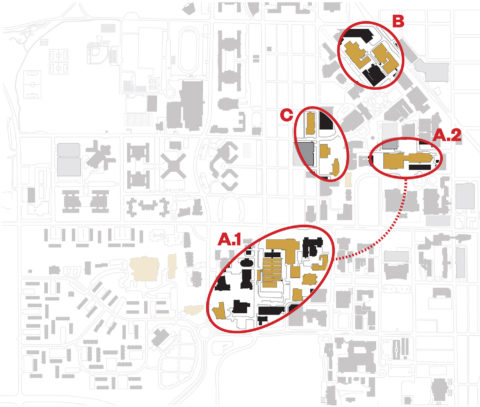
Purdue University, College of Science Master Plan
Conceived with a non-linear “cluster-based” implementation strategy, this master plan innovatively sequenced the upgrades for the College of Science. By identifying underutilized and inefficient building conditions, the master plan proposed ways to recapture campus efficiency (and thus gain space) without adding new facilities.
Purdue’s increased focus on STEM has spurred growth in the College of Science, but with aging facilities, limited resources, and little room for growth, the College was at a crossroads. A comprehensive master planning process was initiated to assess the College’s spaces and establish implementable goals that would allow the College to improve its physical plant, make room for growth, improve recruiting and retention of the highest caliber faculty and students, and bring the sciences together.
The design team held visioning workshops with key stakeholders at the outset to establish goals and an overarching framework for the effort. The group identified the primary qualitative and quantitative objectives necessary to achieve the overall goal, and these objectives were carefully tracked as the stages of the planning process unfolded. The design team executed a comprehensive conditions and needs analysis of the College of Science.
The conclusion drawn from measuring and assessing the facilities was that the College had an abundance of spaces in need of renovation and replacement, but that, overall, those spaces were underutilized. In parallel with on-site investigations, we conducted a thorough benchmarking study of peer schools. The benchmarking study indicated that Purdue University’s College of Science was generally aligned with its peers, but that its facilities skew older and are in greater need of updating.
To create a future-friendly Master Plan that would adapt to evolving conditions within the University, the design team devised a “cluster-based” planning approach in which the College was divided into four “clusters.” Each of the clusters was developed as an independently executable plan, so if any one cluster were thwarted for any reason, work on the overall master plan could continue apace. Working within the clusters, we evaluated each building to determine procedures for renovating and recapturing space through increased efficiency.
Despite the initial mandate to develop a Master Plan with no new buildings, the design team recognized the benefit that an interdisciplinary teaching facility could bring to the University. Soon after adoption of the Master Plan, Purdue elected to build a new STEM teaching lab facility, Chaney-Hale Hall of Science. The building opened in the fall of 2020 and has allowed the College to offload substantial teaching space, opening up swing space options within those buildings and setting the College of Science on course to follow through with the Master Plan.
Details
- Year
- 2017
- Location
- West Lafayette, IN
- Size
- 750,000 ASF across 33 buildings
- Program
- Teaching and Research Labs, Faculty and Grad Student Office Space, Administrative Offices, Classrooms, Collaborative and Public Space, A Comprehensive Assessment of all 6 Departments of the College of Science: Biological Sciences, Chemistry, Mathematics, Statistics, Physics, and Earth, Astronomy, Atmospheric, and Planetary Sciences
Team
- Ennead Design Team
- Todd Schliemann, Alex O'Briant, Emily Kirkland, Jacob Reidel
- Associate Architect
- Jacobs












